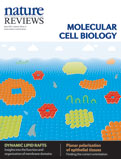|
| TABLE OF CONTENTS | ||||||||||||||||||||||||||||||||||||||||
| June 2017 Volume 18 Number 6 | ||||||||||||||||||||||||||||||||||||||||
| In this issue
| |||||||||||||||||||||||||||||||||||||||
| ||||||||||||||||||||||||||||||||||||||||
 | ||||||||||||||||||||||||||||||||||||||||
| Advertisement | ||||||||||||||||||||||||||||||||||||||||
| ||||||||||||||||||||||||||||||||||||||||
| Advertisement | ||||||||||||||||||||||||||||||||||||||||
| ||||||||||||||||||||||||||||||||||||||||
Comment: Charting the unknown epitranscriptome Eva Maria Novoa, Christopher E. Mason & John S. Mattick p339 | doi:10.1038/nrm.2017.49 Novoa, Mason and Mattick propose to use phage display technology and direct sequencing through nanopores to facilitate systematic interrogation of RNA modifications. Abstract | Full Text | PDF | ||||||||||||||||||||||||||||||||||||||||
| ||||||||||||||||||||||||||||||||||||||||
| REVIEWS | Top | |||||||||||||||||||||||||||||||||||||||
| The HSP90 chaperone machinery Florian H. Schopf, Maximilian M. Biebl & Johannes Buchner p345 | doi:10.1038/nrm.2017.20 The heat shock protein 90 (HSP90) chaperone machinery is a key regulator of proteostasis. Recent progress has shed light on the interactions of HSP90 with its clients and co-chaperones, and on their functional implications. This opens up new avenues for the development of drugs that target HSP90, which could be valuable for the treatment of cancers and protein-misfolding diseases. Abstract | Full Text | PDF | ||||||||||||||||||||||||||||||||||||||||
| The mystery of membrane organization: composition, regulation and roles of lipid rafts Erdinc Sezgin, Ilya Levental, Satyajit Mayor & Christian Eggeling p361 | doi:10.1038/nrm.2017.16 Lipid rafts are relatively ordered membrane domains that are enriched in cholesterol and saturated lipids, and selectively recruit other lipids and proteins. They are dynamic and heterogeneous in composition and are thus challenging to visualize in vivo. New technologies are providing novel insights into the formation, organization and functions of these membrane domains. Abstract | Full Text | PDF | Supplementary information | ||||||||||||||||||||||||||||||||||||||||
| Planar cell polarity in development and disease Mitchell T. Butler & John B. Wallingford p375 | doi:10.1038/nrm.2017.11 Planar cell polarity — the asymmetric distribution of proteins in the plane of a cell sheet — dictates the orientation of various subcellular structures and drives collective cell rearrangements. Better understanding of this conserved axis of polarity can shed light on the mechanisms of morphogenetic processes and explain the underlying causes of human birth defects. Abstract | Full Text | PDF | Supplementary information | ||||||||||||||||||||||||||||||||||||||||
| PERSPECTIVES | Top | |||||||||||||||||||||||||||||||||||||||
| OPINION Global treadmilling coordinates actin turnover and controls the size of actin networks Marie-France Carlier & Shashank Shekhar p389 | doi:10.1038/nrm.2016.172 In animal cells, actin is dynamically distributed between multiple coexisting arrays. Carlier and Shekhar propose that a global treadmilling process — whereby the various actin networks grow and shrink depending on the local activity of actin regulators — establishes a steady-state concentration of actin monomers that supports this homeostatic actin turnover. Abstract | Full Text | PDF | Supplementary information | ||||||||||||||||||||||||||||||||||||||||
| ||||||||||||||||||||||||||||||||||||||||
You have been sent this Table of Contents Alert because you have opted in to receive it. You can change or discontinue your e-mail alerts at any time, by modifying your preferences on your nature.com account at: www.nature.com/myaccount For further technical assistance, please contact our registration department For print subscription enquiries, please contact our subscription department For other enquiries, please contact our feedback department Springer Nature | One New York Plaza, Suite 4500 | New York | NY 10004-1562 | USA Springer Nature's worldwide offices: Macmillan Publishers Limited is a company incorporated in England and Wales under company number 785998 and whose registered office is located at The Campus, 4 Crinan Street, London, N1 9XW. © 2017 Macmillan Publishers Limited, part of Springer Nature. All Rights Reserved. |
 |









No comments:
Post a Comment